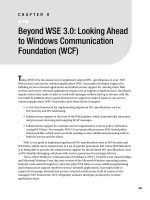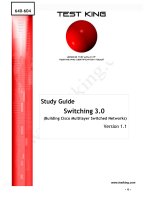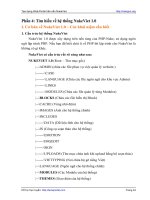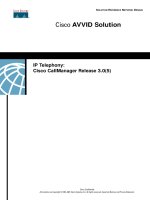mastering enterprise javabeans 3.0 4th ed 2006
Bạn đang xem bản rút gọn của tài liệu. Xem và tải ngay bản đầy đủ của tài liệu tại đây (9.96 MB, 722 trang )
TIMELY. PRACTICAL. RELIABLE.
Rima Patel Sriganesh
Gerald Brose
Micah Silverman
Wiley Technology Publishing
Timely. Practical. Reliable.
An invaluable tutorial on the dramatic changes to
Enterprise JavaBeans (EJB
™
) 3.0
Covering basic through advanced subjects,
Mastering Enterprise JavaBeans 3.0 is
more than 50 percent new and revised.
Four new chapters and one new appendix
cover the latest features of this new release,
and in-depth coverage of the Java™
Persistence API and the entities defined
therein is provided. The authors’ main
goal is to get you programming with EJB
immediately. To that end, you’ll learn:
• How to implement EJB 3.0 beans,
with emphasis on session beans
(stateful and stateless) and mes-
sage-driven beans
• Both basic and advanced concepts
(such as inheritance, relationships,
and so on) of Java Persistence API
defined entities
• How to develop and deploy EJB 3.0
Web services
• How to secure EJB applications
• How to integrate EJB applications
with the outside world via the Java
EE Connector technology
• Tips and techniques for designing and
deploying EJB for better performance
• How clustering in large-scale EJB
systems works
Visit the companion Web site at www.wiley.com/go/sriganesh
Mastering Enterprise JavaBeans
™
3.0
Sriganesh
Brose
Silverman
Programming Languages/Java $45.00 USA/$58.99 CAN/£29.99 UK
ISBN: 0-471-78541-5
Mastering Enterprise
JavaBeans
™
3.0
Featuring myriad changes from its
previous versions, EJB 3.0 boasts a
very different programming and
deployment model, with nearly every
aspect of development affected. Even the
most experienced EBJ and J2EE™
developers will need to relearn how to
best use EJB to develop mission-critical
applications. This author team of experts
has taken their combined skills in
architecture, development, consulting,
and knowledge transfer to explain the
various changes to EJB 3.0 as well as
the rationale behind these changes.
You’ll learn the concepts and techniques
for authoring distributed, enterprise
components in Java from the ground up.
• Best practices for EJB application
design, development, and testing
Rima Patel Sriganesh is a staff engi-
neer in the technology outreach
group at Sun Microsystems, Inc.
She speaks frequently at major
industry conferences and is a
coauthor of
Mastering Enterprise
JavaBeans, Third Edition
(Wiley).
Gerald Brose works for Projektron,
a German vendor for project man-
agement software. He maintains
the Open Source ORB JacORB.
Gerald holds a Ph.D. in computer
science and has published widely on
Java, CORBA, and security.
Micah Silverman, a Software
Architect for 15 years, has special-
ized in Java since 1995. He founded
M*Power Internet Services, Inc.,
providing architect, development,
and security services. He has
contributed to books and published
numerous articles.
The companion Web site provides
all the source code, updates to the
source code examples, and a PDF
version of the book.
785415 Cover_rb2.qxp 5/25/06 2:14 PM Page 1
Mastering Enterprise
JavaBeans
™
3.0
01_785415 ffirs.qxp 6/5/06 7:09 PM Page i
01_785415 ffirs.qxp 6/5/06 7:09 PM Page ii
Rima Patel Sriganesh
Gerald Brose
Micah Silverman
Mastering Enterprise
JavaBeans
™
3.0
01_785415 ffirs.qxp 6/5/06 7:09 PM Page iii
Click here to purchase this book.
Mastering Enterprise JavaBeans™ 3.0
Published by
Wiley Publishing, Inc.
10475 Crosspoint Boulevard
Indianapolis, IN 46256
www.wiley.com
Copyright © 2006 by Wiley Publishing, Inc., Indianapolis, Indiana
Published simultaneously in Canada
ISBN-13: 978-0-471-78541-5
ISBN-10: 0-471-78541-5
Manufactured in the United States of America
10 9 8 7 6 5 4 3 2 1
1B/SS/QW/QW/IN
No part of this publication may be reproduced, stored in a retrieval system or transmitted in any form or by any
means, electronic, mechanical, photocopying, recording, scanning or otherwise, except as permitted under Sec-
tions 107 or 108 of the 1976 United States Copyright Act, without either the prior written permission of the Pub-
lisher, or authorization through payment of the appropriate per-copy fee to the Copyright Clearance Center,
222 Rosewood Drive, Danvers, MA 01923, (978) 750-8400, fax (978) 646-8600. Requests to the Publisher for per-
mission should be addressed to the Legal Department, Wiley Publishing, Inc., 10475 Crosspoint Blvd., Indi-
anapolis, IN 46256, (317) 572-3447, fax (317) 572-4355, or online at />Limit of Liability/Disclaimer of Warranty: The publisher and the author make no representations or war-
ranties with respect to the accuracy or completeness of the contents of this work and specifically disclaim all
warranties, including without limitation warranties of fitness for a particular purpose. No warranty may be
created or extended by sales or promotional materials. The advice and strategies contained herein may not be
suitable for every situation. This work is sold with the understanding that the publisher is not engaged in ren-
dering legal, accounting, or other professional services. If professional assistance is required, the services of a
competent professional person should be sought. Neither the publisher nor the author shall be liable for dam-
ages arising herefrom. The fact that an organization or Website is referred to in this work as a citation and/or
a potential source of further information does not mean that the author or the publisher endorses the infor-
mation the organization or Website may provide or recommendations it may make. Further, readers should be
aware that Internet Websites listed in this work may have changed or disappeared between when this work
was written and when it is read.
For general information on our other products and services or to obtain technical support, please contact our
Customer Care Department within the U.S. at (800) 762-2974, outside the U.S. at (317) 572-3993 or fax (317)
572-4002.
Library of Congress Cataloging-in-Publication Data
Sriganesh, Rima Patel.
Mastering enterprise JavaBeans 3.0 / Rima Patel Sriganesh, Gerald Brose,
Micah Silverman.
p. cm.
Includes index.
ISBN-13: 978-0-471-78541-5 (paper/website)
ISBN-10: 0-471-78541-5 (paper/website)
1. JavaBeans. 2. Java (Computer program language) I. Brose, Gerald. II. Silverman, Micah. III. Title.
QA76.73.J38S756 2006
005.13'3 dc22
2006011333
Trademarks: Wiley, the Wiley logo, and related trade dress are trademarks or registered trademarks of John
Wiley & Sons, Inc. and/or its affiliates, in the United States and other countries, and may not be used without
written permission. Enterprise JavaBeans is a trademark of Sun Microsystems, Inc. All other trademarks are
the property of their respective owners. Wiley Publishing, Inc., is not associated with any product or vendor
mentioned in this book.
Wiley also publishes its books in a variety of electronic formats. Some content that appears in print may not
be available in electronic books.
01_785415 ffirs.qxp 6/5/06 7:09 PM Page iv
Rima wishes to dedicate this book to her dearest and most loving
Mummy and Papa, on their completing 60 years of a wholesome and
exemplary life this year, and to her beloved husband, Sriganesh.
To my wonderful wife, Christine, and my sons Johannes and Julius.
For Dr. Charles Marshall, who taught me Excellence.
01_785415 ffirs.qxp 6/5/06 7:09 PM Page v
01_785415 ffirs.qxp 6/5/06 7:09 PM Page vi
Rima Patel Sriganesh is a staff engineer presently working in the Technology
Outreach group at Sun Microsystems, Inc. She specializes in Java, XML, and inte-
gration platforms. Rima represents Sun at various financial services standards.
She is a coauthor of three books and usually publishes her take on technology
in the form of papers and blogs. She also speaks frequently at various industry
conferences.
Rima graduated in Mathematics from M.S. University, Gujarat, India. She
currently lives with her husband in the Greater Boston area.
Gerald Brose works as head of software development for Projektron, a soft-
ware vendor that produces project management software. In previous jobs he
has worked as a product manager, software architect, and researcher. He holds
a Ph.D. in computer science.
Gerald is an expert in distributed object computing and middleware secu-
rity, including CORBA, J2EE, and Web services. Gerald also coauthored Java
Programming with CORBA, also published by Wiley.
Gerald is the maintainer of the JacORB project, the most widely used open
source ORB for Java, which is part of the JBoss and JOnAS J2EE application
servers. He lives with his wife and two sons in Berlin, Germany.
Micah Silverman has been a professional software architect and consultant for
over 15 years. He has been developing with Java since its release in 1995. In
that same year, he founded M*Power Internet Services, Inc., a consulting com-
pany providing software architecting, development, and security services. He
has written numerous articles on software development, information security,
and operating systems.
About the Authors
vii
01_785415 ffirs.qxp 6/5/06 7:09 PM Page vii
Click here to purchase this book.
01_785415 ffirs.qxp 6/5/06 7:09 PM Page viii
Executive Editor
Robert Elliott
Development Editor
Tom Dinse
Technical Editor
Daniel Rubio
Production Editor
Felicia Robinson
Copy Editor
Foxxe Editorial Services
Editorial Manager
Mary Beth Wakefield
Production Manager
Tim Tate
Vice President and Executive
Group Publisher
Richard Swadley
Vice President and
Executive Publisher
Joseph B. Wikert
Project Coordinator
Michael Kruzil
Graphics and Production
Specialists
Jennifer Click
Lauren Goddard
Joyce Haughey
Stephanie D. Jumper
Barry Offringa
Lynsey Osborn
Heather Ryan
Brent Savage
Alicia B. South
Quality Control Technicians
Amanda Briggs
Jessica Kramer
Proofreading and Indexing
Techbooks
Credits
ix
01_785415 ffirs.qxp 6/5/06 7:09 PM Page ix
Click here to purchase this book.
01_785415 ffirs.qxp 6/5/06 7:09 PM Page x
About the Authors vii
Acknowledgments xxiii
Introduction xxv
Part I Overview 1
Chapter 1 Overview 3
A Prelude to Enterprise JavaBeans 4
Software Components 4
The Need for Componentization 4
Infrastructure Needs of Distributed Applications 5
Application Server–Class Software 8
Building Middleware Services from Scratch 8
Buying Middleware Services via Application Server Software 9
Standardization of Component Frameworks 9
Enterprise JavaBeans Technology 10
Why Java? 11
EJB as a Business Tier Component 12
Distributed Computing: The Foundation of EJB 14
EJB Middleware Services 16
Explicit Middleware Approach 16
Implicit Middleware Approach 17
Implicit vs. Explicit Middleware Services in EJB 18
Roles in the EJB Application Life Cycle 18
The Bean Provider 19
The Application Assembler 19
The EJB Deployer 20
The System Administrator 20
Contents
xi
02_785415 ftoc.qxp 6/5/06 6:53 PM Page xi
Click here to purchase this book.
EJB Ecosystem 22
EJB Container 24
EJB Tools 24
Service-Oriented Architectures and Enterprise JavaBeans 25
Defining Service-Oriented Architectures 26
SOA and Web Services 26
SOA and Component Architectures 27
Divide and Conquer to the Extreme with Reusable Services 27
The Java Platform, Enterprise Edition 5.0 (Java EE) 29
The Java EE Technologies 31
Summary 34
Chapter 2 Pre-EJB 3.0: The World That Was 37
What Constituted a Pre-EJB 3.0 Enterprise Bean? 38
Developing and Deploying a Pre-EJB 3.0 Enterprise Java Bean 41
The Remote Interface 42
The Local Interface 43
The Home Interface 44
The Local Home Interface 45
The Bean Class 45
Deployment Descriptor 47
Deploying The Bean 47
HelloWorldEJB Client 48
Dissecting EJB 2.x 50
Complexity: The Overarching Issue of EJB 2.x 50
Development Complexities 51
Deployment Complexities 53
Debugging and Testing Complexities 54
What Needs to Be Done to Improve EJB 2.x? 55
Summary 55
Chapter 3 The New Enterprise JavaBean 57
Introducing EJB 3.0 57
EJB Container 59
Types of Beans 61
RMI-IIOP: The Protocol of the Bean 65
EJB and Location Transparency 66
Enterprise Bean Environment 67
Anatomy of the “New” Bean 68
The Role of EJB Home and Object Interfaces 72
The EJB 3.0 Simplified API 73
Elimination of Home and Object Interfaces 74
Elimination of Component Interface 74
Use of Annotations 76
Annotations and Bean Development 77
Annotations and Deployment Descriptors 77
The Good, the Bad, and the Ugly of Deployment Annotations 79
Simplified Access to Environment 80
Packaging and Deployment of the “New” Bean 81
xii Contents
02_785415 ftoc.qxp 6/5/06 6:53 PM Page xii
Example of EJB 3.0 Bean 82
The Business Interface 83
The Bean Class 83
The Deployment Descriptor 84
The Client 85
Summary of Terms 86
Summary 87
Part II The Triad of Beans and Entities 89
Chapter 4 Introduction to Session Beans 91
Session Bean Lifetime 91
Session Bean Subtypes 92
Stateless Session Beans 92
Stateful Session Beans 94
Special Characteristics of Stateful Session Beans 94
Achieving the Effect of Pooling with Stateful Beans 95
The Rules Governing Conversational State 96
Activation and Passivation Callbacks 97
Summary of Callback Methods 100
A Simple Stateful Session Bean 100
The Count Bean’s Remote Interface 100
The Count Bean 102
The Count Bean’s Callback Interceptor 104
The Count Bean’s Deployment Descriptor 106
The Count Bean’s Proprietary Descriptor and Ejb-jar File 107
The Count Bean’s Client Code 107
Running the Client 109
Life-Cycle Diagrams for Session Beans 110
Summary 114
Chapter 5 Writing Session Bean Web Services 115
Web Services Concepts 115
Web Services Standards 118
WSDL 118
SOAP 120
XML Artifacts and Platform Independence 121
Implementing a Web Service 122
WSDL and the XML/Java Mapping 125
Packaging and Deploying a Web Service Session Bean 125
Implementing a Web Service Client 126
Summary 128
Chapter 6 Java Persistence: Programming with Entities 129
Object-Relational Mapping 130
What Is an Entity? 133
Entities versus Session Beans 134
Persistence Provider 135
Entity Classes 135
Contents xiii
02_785415 ftoc.qxp 6/5/06 6:53 PM Page xiii
Accessing Entities in the Persistence Context 138
Extended Persistence Context 141
Packaging and Deploying Entity Classes 143
The EntityManager API 144
Entity Life Cycle 145
Life-Cycle Callbacks 147
Database Synchronization 148
Direct Entity Data Manipulation 149
Concurrent Access and Locking 150
Entity Lookup and Query API 153
Named Queries 154
Summary 155
Chapter 7 Introduction to Message-Driven Beans 157
Motivations for Messaging 157
The Java Message Service (JMS) 160
Messaging Domains 161
The JMS API 162
Integrating JMS with EJB 167
What Is a Message-Driven Bean? 169
Developing Message-Driven Beans 173
The Semantics 173
A Simple Example 175
The Bean Implementation Class 175
The Deployment Descriptor 177
More Metadata: Activation Configuration Properties 178
The Client Program 183
Advanced Concepts 183
Transactions 183
Security 183
Load Balancing 183
Duplicate Consumption in a Cluster 184
JMS Message-Driven Bean Gotchas 186
Message Ordering 186
Missed @PreDestroy Calls 186
Poison Messages 187
How to Return Results Back to Message Producers 190
An Alternative Request/Response Paradigm 194
The Future: Asynchronous Method Invocations 195
Summary 195
Chapter 8 Adding Functionality to Your Beans 197
Calling Beans from Other Beans 197
Default JNDI Lookups 198
Annotations 199
Common Annotations 200
Business Interface Annotations 200
Other Stateful Annotations 202
xiv Contents
02_785415 ftoc.qxp 6/5/06 6:53 PM Page xiv
Dependency Injection 205
Resource References 205
Interceptors 209
Summary 214
Part III Advanced Enterprise JavaBeans Concepts 217
Chapter 9 Advanced Persistence Concepts 219
Inheritance 220
Single Table per Class Hierarchy 223
Separate Table per Subclass 230
Single Table per Concrete Entity Class 232
Other Modes of Inheritance 232
Polymorphism 234
Relationships 237
Relationship Types 237
One-to-One 238
One-to-Many 245
Many-to-Many 254
EJB-QL Enhancements 261
Bulk Updates and Deletes 261
JOIN Operations 265
GROUP BY and HAVING clauses 266
Projection 267
Fun with Queries 268
Dynamic Queries and Named Parameters 268
Subqueries 268
Object Construction in SELECT Statements 269
Summary 270
Chapter 10 Transactions 271
Motivation for Transactions 272
Atomic Operations 272
Network or Machine Failure 273
Multiple Users Sharing Data 274
Benefits of Transactions 275
The ACID Properties 276
Transactional Models 278
Flat Transactions 278
How Transactional State Is Rolled Back 280
Nested Transactions 280
Other Transactional Models 281
Distributed Transactions 282
Durability and the Two-Phase Commit Protocol 283
The Transactional Communications Protocol
and Transaction Contexts 285
Contents xv
02_785415 ftoc.qxp 6/5/06 6:53 PM Page xv
Java Transaction Service and Java Transaction API 285
OTS and Java Transaction Service 285
The Java Transaction API 286
JTS and Distributed Transaction Interoperability
across Application Servers 287
Enterprise JavaBeans Transactions 288
Underlying Transaction System Abstraction 288
Container-Managed, Bean-Managed, and
Client-Controlled Transactions 288
Container-Managed Transactions 289
Client-Controlled Transactions 290
Choosing a Transaction Style 291
Container-Managed Transactions 292
EJB Transaction Attribute Values 293
Required 293
RequiresNew 294
Supports 294
Mandatory 294
NotSupported 295
Never 295
Transaction Attribute Summary 295
Container-Managed Transaction Example 296
Applicability of Transaction Attributes to Various Beans 300
Bean-Managed Transactions 302
The javax.transaction.UserTransaction Interface 303
Bean-Managed Transaction Example 306
Client-Controlled Transactions 307
Transactional Isolation 307
The Need for Concurrency Control 308
Isolation Levels 310
The Dirty Read Problem 310
READ UNCOMMITTED 311
READ COMMITTED 311
The Unrepeatable Read Problem 312
REPEATABLE READ 312
The Phantom Problem 313
SERIALIZABLE 313
Transaction Isolation Summary 314
Using Various Isolation Levels in EJB Applications 314
Pessimistic and Optimistic Concurrency Control 315
Designing Transactional Conversations in EJB 316
Summary 319
xvi Contents
02_785415 ftoc.qxp 6/5/06 6:53 PM Page xvi
Chapter 11 Security 321
Introduction 322
Violations, Vulnerabilities, and Risk 323
Controls 323
Web Application Security 325
Authentication in Web Applications 326
Authorization 327
Confidentiality and Integrity 328
Understanding EJB Security 329
Authentication in EJB 329
JAAS Overview 329
The JAAS Architecture 331
JAAS Sample Code 333
Authorization in EJB 341
Security Roles 341
Performing Programmatic Authorization 342
Performing Declarative Authorization 346
Declarative or Programmatic? 351
Security Propagation 351
Secure Interoperability 353
IIOP/SSL 353
CSIv2 354
Web Services Security 356
End-to-End Security 357
XML Digital Signature and XML Encryption 358
SAML 361
WS-Security 362
Summary 364
Chapter 12 EJB Timers 365
Scheduling 365
EJB and Scheduling 366
The EJB Timer Service 368
Timer Service API 368
javax.ejb.TimerService 369
javax.ejb.Timer 370
javax.ejb.TimedObject 370
javax.ejb.TimerHandle 371
Interaction between the EJB and the Timer Service 371
Timer Example: CleanDayLimitOrdersBean 373
The CleanDayLimitOrders Business Interface 374
The CleanDayLimitOrdersBean Class 374
The CleanDayLimitOrders EJB Deployment Descriptor 376
The CleanDayLimitOrders EJB Client 377
Running the Client 378
Strengths and Limitations of EJB Timer Service 379
Summary 380
Contents xvii
02_785415 ftoc.qxp 6/5/06 6:53 PM Page xvii
Chapter 13 EJB Best Practices 381
When to Use EJB 382
How to Choose a Web Application Framework
to Work with EJB 385
Applying Model Driven Development in EJB Projects 387
Applying Extreme Programming in EJB Projects 389
Testing EJB 392
EJB Unit Testing 392
Use Frameworks for EJB Unit Testing 393
The JUnit Framework 393
Mock Object Frameworks 394
Implementing Client-Side Callback Functionality in EJB 395
JMS 395
Remote Method Invocation 396
Web Service 396
Choosing between Servlets and Stateless
Session Beans as Service Endpoints 396
Considering the Use of Aspect-Oriented Programming
Techniques in EJB Projects 397
Aspect-Oriented Programming 397
When to Use AOP in EJB Applications 398
Support Custom Concerns 398
Are Interceptors AOP? 398
Supply Aspects to the World Outside the EJB Container 399
Reflection, Dynamic Proxy, and EJB 400
Deploying EJB Applications to Various Application Servers 400
Debugging EJB 402
Inheritance and Code Reuse in EJB 404
Writing Singletons in EJB 405
When to Use XML with EJB 406
When to Use Messaging versus RMI-IIOP 407
Summary 410
Chapter 14 EJB Performance Optimizations 411
It Pays to Be Proactive! 411
The Stateful versus Stateless Debate from a
Performance Point of View 413
How to Guarantee a Response Time with Capacity Planning 415
Use Session Façade for Better Performance 416
Choosing between Local Interfaces and Remote Interfaces 418
Partitioning Your Resources 419
Tuning Stateless Session Beans 420
Tuning Stateful Session Beans 421
Tuning Entities 423
Tuning Message-Driven Beans 426
Tuning Java Virtual Machine 427
Miscellaneous Tuning Tips 429
Choosing the Right EJB Server 430
Summary 431
xviii Contents
02_785415 ftoc.qxp 6/5/06 6:53 PM Page xviii
Chapter 15 EJB Integration 433
Why Does Integration Matter? 433
Integration Styles 434
EJB and Integration 435
Java EE Connector Architecture 436
Why Java EE Connectors? 436
Integrating Java EE Platform with Non-IIOP World 436
The M x N Integration Problem 436
The Infrastructure Services Problem 438
Resource Adapter Interaction with Java EE Components 439
Resource Adapter Interaction with Application Server 440
The Java EE Connector API 442
The javax.resource Package 442
The javax.resource.cci Package 443
The javax.resource.spi Package 443
The javax.resource.spi.endpoint Package 451
The javax.resource.spi.security Package 451
The javax.resource.spi.work Package 452
System Contracts 453
Life Cycle Management 453
Connection Management 454
Security Management 458
Container-Managed Sign-On 458
Component-Managed Sign-On 459
Transaction Management 460
Local Transaction Management Contract 460
Global Transaction Management Contract 461
Work Management 462
Message Inflow 464
Connector Example: OutboundLoanRA 467
Example Architecture 468
JavaLoanApp.java 469
LoanApp.dll 470
OutboundLoanRA 471
OutboundLoanRA Client Contracts 471
OutboundLoanRA System Contracts 485
Deploying OutboundLoanRA 493
LoanRatesEJB 495
Developing LoanRatesEJB 495
LoanRatesClient 496
Running the Client 497
Extending OutboundLoanRA 502
Integration Best Practice: When to Use Which Technology 502
When to Use JMS and JMS-Based MDB 502
When to Use Java EE Connectors 503
When to Use Java Web Services 503
Summary 504
Contents xix
02_785415 ftoc.qxp 6/5/06 6:53 PM Page xix
Chapter 16 Clustering 505
Overview of Large-Scale Systems 505
What Is a Large-Scale System? 506
Load Balancing and Failover 509
Clustering with Collocated or Distributed Java EE Containers 512
Instrumenting Clustered EJBs 516
How EJBs Can Be Clustered 516
The Concept of Idempotence 518
Stateless Session Bean Clustering 519
Load Balancing 519
Failover 519
Stateful Session Bean Clustering 521
Load Balancing 522
Failover 522
Entity Clustering 523
Load Balancing 523
Failover 523
Caching 523
Read-Only Caches 524
Distributed Shared Object Caches 524
Read-Mostly Caches 525
Message-Driven Bean Clustering 526
Other EJB Clustering Issues 526
First Contact 527
Initial Access Logic 527
Summary 528
Chapter 17 EJB-Java EE Integration: Building a Complete Application 529
The Business Problem 529
A Preview of the Final Web Site 530
Scoping the Technical Requirements 534
The Business Logic Tier 534
Persistent Data: Entities 534
Business Logic: Session and Message-Driven Beans 538
The Presentation Tier 541
What Are Servlets? 541
What Are Java Server Pages? 543
How Do I Combine Servlets, JSP, and EJB Components? 543
JSP Files in Our E-Commerce Deployment 544
Example Code 547
Summary 558
Appendix A RMI-IIOP and JNDI Tutorial 559
Java RMI-IIOP 560
Remote Method Invocations 560
The Remote Interface 563
The Remote Object Implementation 564
Stubs and Skeletons 566
xx Contents
02_785415 ftoc.qxp 6/5/06 6:53 PM Page xx
Object Serialization and Parameter Passing 568
Passing by Value 568
Object Serialization 568
Rules for Serialization 569
What Should You Make Transient? 570
Object Serialization and RMI 571
Pass-by-Reference Semantics 572
CORBA Interoperability with RMI-IIOP 573
The Big Picture: CORBA and EJB Together 575
The Java Naming and Directory Interface 576
Why Use JNDI? 576
Naming and Directory Services 576
Problems with Naming and Directories 579
Enter JNDI 579
Benefits of JNDI 579
The JNDI Architecture 580
JNDI Concepts 581
Naming Systems, Namespaces, and Composite Names 582
Initial Context Factories 584
Programming with JNDI 586
Integrating RMI-IIOP and JNDI 588
Binding an RMI-IIOP Server to a JNDI Name 589
Looking Up an RMI-IIOP Server with JNDI 590
Summary 591
Appendix B Annotations 593
Introduction to Annotations 593
Annotations for EJB 596
Background 597
XDoclet 597
Annotations in Java 598
Pros and Cons 598
EJB Annotation Reference 599
Bean Type Annotations 599
Common Annotations for Session and 603
Message-Driven Beans
Entity Annotations 611
Summary 645
Index 647
Contents xxi
02_785415 ftoc.qxp 6/5/06 6:53 PM Page xxi
02_785415 ftoc.qxp 6/5/06 6:53 PM Page xxii
This book has been a project spanning several years. Many have commented that
the first edition was one of the best technical books they’ve ever read. What’s
made this book a reality are the many people who aided in its development.
As a special thanks, we’d like to acknowledge the great folks at John Wiley &
Sons. They have been absolutely outstanding throughout this book’s evolution.
In particular, we thank Bob Elliott, Tom Dinse, and Mary Beth Wakefield for
their incredible efforts. We also thank Daniel Rubio for his insightful technical
reviews, and Linda DeMichiel for lending her help to the authors in under-
standing the evolution of EJB 3.0 standard.
I would like to thank my wife, Tes and my daughter, Shaina for being so
patient while I worked on this book.
—Micah
Acknowledgments
xxiii
03_785415 flast.qxp 6/5/06 6:53 PM Page xxiii
Click here to purchase this book.









